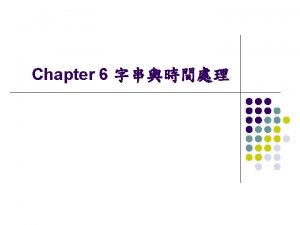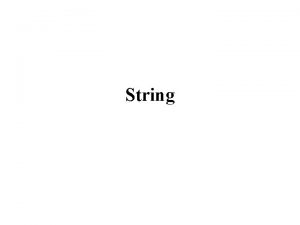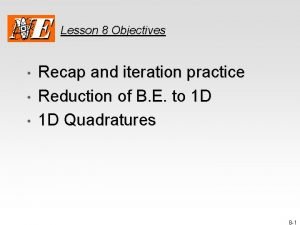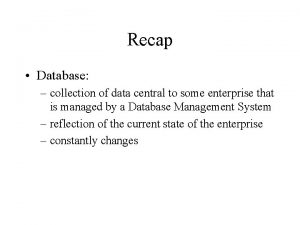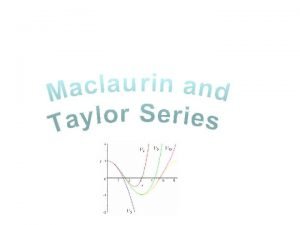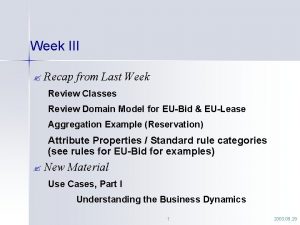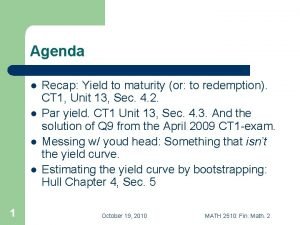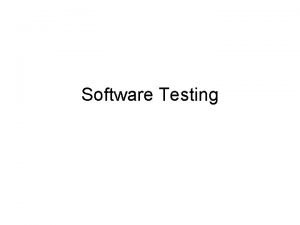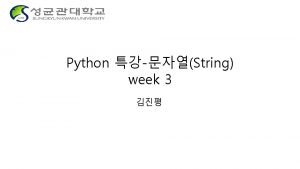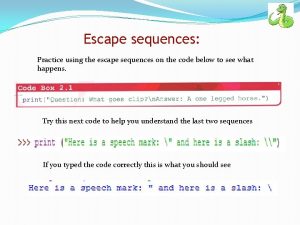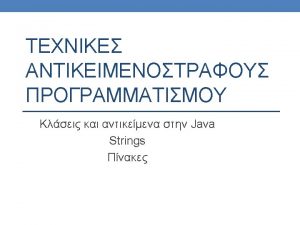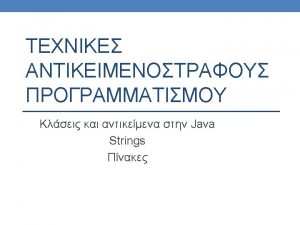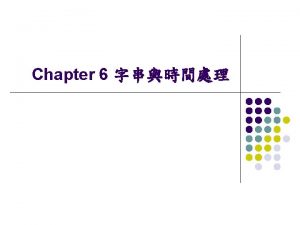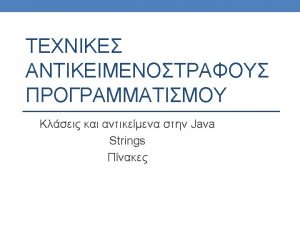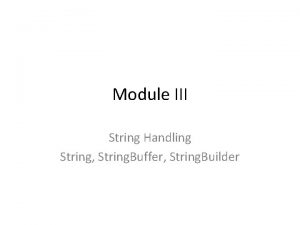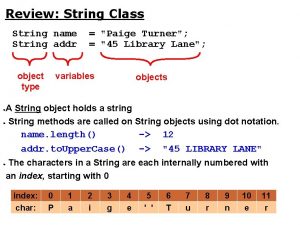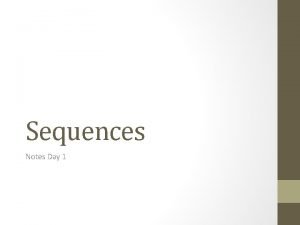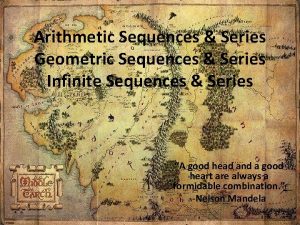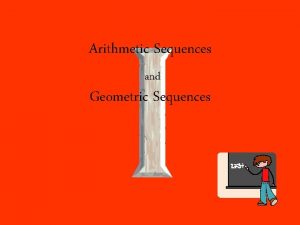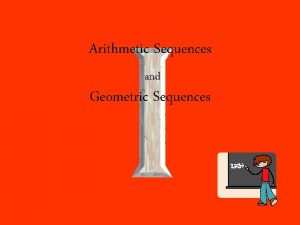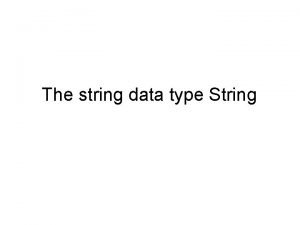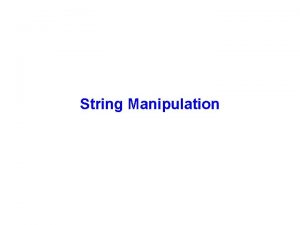File Processing Recap String Processing Review Escape Sequences



























- Slides: 27

File Processing Recap

String Processing: Review Escape Sequences: print the unprintable '<symbol>': escape sequence 'n': newline 't': tab '"': " >>> print 'Hellon. World' Hello World >>> x = eval('40n') x = 40

File Processing Review: Open File >>> infile = open('myfile. txt', 'r') >>> outfile = open('myfile. txt', 'w') Manipulate File Read Write Close File >>> infile. close()

File Processing Review: Writing outfile. write(<string>) Reading infile. read() infile. readlines() infile. readline() myfile. txt Spam and Eggs >>> infile = open('mytext. txt', 'r') >>> x = infile. read() >>> x 'Spamnandn. Eggsn'

File Processing Review: Starts from last line read myfile. txt >>> x = infile. readline() >>> x 'Spamn‘ Spam and Eggs >>> x = infile. readlines() >>> x ['andn', 'Eggsn‘] To start from the beginning of the file, need to close and reopen

End of the File? . read(), . readlines(): read until end of file . readline()? Empty string ('') x = 'stuff' while x != '': x = infile. readline() print x Files are sequences! for line in infile: <process the line> Spam and Eggs

Recursion

Rock, Paper, Scissors def main(): # define items # Player and Computer make their selection. . . # inform Player of choices # figure out who wins # print out results of the game main() # invoke the program

Rock, Paper, Scissors def main(): # define items # initialize score # Player and Computer make their selection. . . # inform Player of choices # figure out who wins and update score # print out results of the game main() # invoke the program

Rock, Paper, Scissors # initialize score def main(): # define # Player # inform # figure Recursion items and Computer make their selection. . . Player of choices out who wins and update score # ask if user wants to play again if play_again == 'Y': main() else: # print out results of the game main() # invoke the program

Recursion Function being defined is invoked within its own definition Usually do not recurse main

Rock, Paper, Scissors # initialize score def main(): # define # Player # inform # figure items and Computer make their selection. . . Player of choices out who wins and update score # ask if user wants to play again if play_again == 'Y': main() else: # print out results of the game main() # invoke the program

A Better Recursive Solution. . . def playgame(score): # Player and Computer make their selection. . . # inform Player of choices # figure out who wins and update score # ask if user wants to play again if play_again == 'Y': playgame(score) else: # print out results of the game def main(): # define items # initialize score playgame(score) # play the game main() # invoke the program

Recursion Some problems can only be solved with recursion: 3! = 3 Factorial = 3 * 2 * 1 = 6 n! = n * (n – 1) * (n – 2) *. . . * (n – (n - 1)) 1! = 1, 0! = 1 def factorial(n): if n <= 1: return 1 else: return factorial(n-1)

Recursion def factorial(n): if n <= 1: return 1 else: return n * factorial(n-1) def main(): factorial(4) Stack factorial(1) factorial(2) factorial(3) main() factorial(4) A lot of overhead main()

Rock, Paper, Scissors def main(): # define items # initialize score # Player and Computer make their selection. . . # inform Player of choices # figure out who wins and update score # print out results of the game main() # invoke the program

A Better Solution def main(): # define items # initialize score done = 'N' while done == 'N': # Player and Computer make their selection. . . # inform Player of choices # figure out who wins and update score # ask if user wants to play again # print out results of the game main() # invoke the program

Multivariate Data CMSC 120: Visualizing Information Lecture 4/17/08

Types of Analysis Univariate Bivariate A single attribute Two attributes Characterize Observations Number Type Similarity Describe Associations How variables simultaneously change together Are two groups the same? Is there a relationship? What is the nature of the relationship?

Bivariate Analysis How two variables co-vary How two variables are correlated Describes a how a change in one variable is related to a change in another Relationships are not causal!

Bivariate Analysis How two variables co-vary Describes the degree of similarity between two variables (X, and Y) Measure of how two variables vary together about the mean How two variables are correlated Indicates strength and directionality of a linear relationship between X and Y Departure of relationship from independence

Lizard Plant Lizard 10. 1 8. 4 Plant 8. 4 12. 0 25 20 15 Plant Diversity 10 -15 5 0 -10 Correlation -5 0 5 10 15 -5 -10 -15 -20 X Y X Variance Covariance Y Covariance Variance Lizard Diversity

Multivariate Data 3 or more variables Extension of Bivariate Relationships among Variates

Multivariate Visualization

Projection Image of an imaginary multi-dimensional object is projected on a planar (2 -D surface) Mathematical calculation

Projection Image of an imaginary multi-dimensional object is projected on a planar (2 -D surface) Mathematical calculation

Projection Image of an imaginary multi-dimensional object is projected on a planar (2 -D surface) Mathematical calculation Distort the data
 Licenseid=string&content=string&/paramsxml=string
Licenseid=string&content=string&/paramsxml=string Escape sequence in c
Escape sequence in c File-file yang dibuat oleh user pada jenis file di linux
File-file yang dibuat oleh user pada jenis file di linux Const char * vs char * const
Const char * vs char * const Private string name
Private string name 3600000/24
3600000/24 C string review
C string review Physical image vs logical image
Physical image vs logical image Fungsi dari create file pada operasi-operasi file (cont.)
Fungsi dari create file pada operasi-operasi file (cont.) Remote file access in distributed file system
Remote file access in distributed file system An html file is a text file containing small markup tags.
An html file is a text file containing small markup tags. In a file-oriented information system, a transaction file
In a file-oriented information system, a transaction file Shawshank redemption summary
Shawshank redemption summary Chapter 8 summary the great gatsby
Chapter 8 summary the great gatsby Segmented pricing
Segmented pricing What is the purpose of an iteration recap
What is the purpose of an iteration recap Recap intensity clipping
Recap intensity clipping 60 minutes recap
60 minutes recap Recap database
Recap database Differentiation recap
Differentiation recap Sample script for recapitulation
Sample script for recapitulation Recap introduction
Recap introduction Recap from last week
Recap from last week Act 4 the crucible discussion questions
Act 4 the crucible discussion questions What theological argument does john
What theological argument does john Logbook recap example
Logbook recap example Ytm recap
Ytm recap Black box recap
Black box recap





